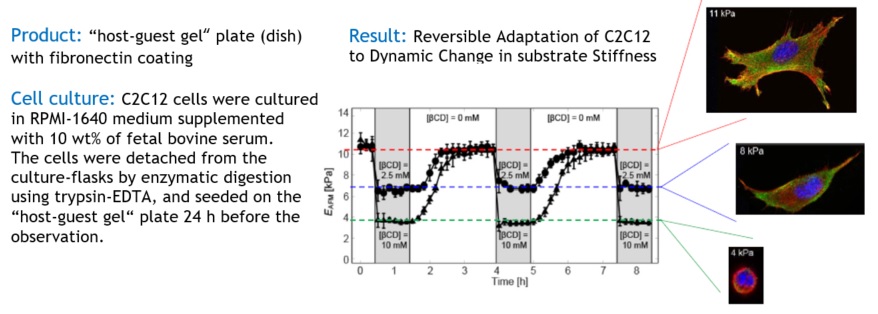Cell culture substrate with user-controllable stiffness
January 4, 2021
Elasticity of the hydrogel is reversibly altered by using non-cytotoxic reagent
Background / Context / Abstract:
Mechanobiology is an emerging field in bioscience. Cells have a capability to adapt to dynamic changes in mechanical environments during development and disease progression (Discher, Wang, Janmey, Science, 310, 1139 (2005)). In contrast to chemically cross-linked polymer substrates, “dynamic” substrates enabling the reversible switching of stiffness open a large potential to study how cells respond to mechanical “stresses”. Despite of a strong demand by researchers, most of previous dynamic substrates either utilize cyto-toxic cues such as UV light and temperature change or can change the stiffness only once.
Technology Overview:
Osaka University researchers have developed a new “host-guest gel”, whose stiffness can reversibly be switched by dissolving competing host/guest molecules in solutions. It enables us to recapitulate dynamic changes in extracellular microenviroments. We demonstrated the morphological swithcing of somatic cells and the maintenance of human/mouse stem cell functions on our hydrogels over a month.
Benefits:
・You can modify the stiffness of substrates on your demand while cell culturing.
・This is the first product that you can reversibly change the mechanical environments of cells.
Applications:
The cell culture kit with this substrate is applicable for any typesof cells
State of Development / Opportunity / Seeking:
●Opportunity
・Available for exclusive and non-exclusive licensing
・Exclusive/non-exclusive evaluation for defined period (set up for options)
・Collaborative/supportive research
●Seeking
・Licensing
・Development partner
IP Status:
WO2018/021289 (PCT applied in Japanese)
Contact:
![]()
